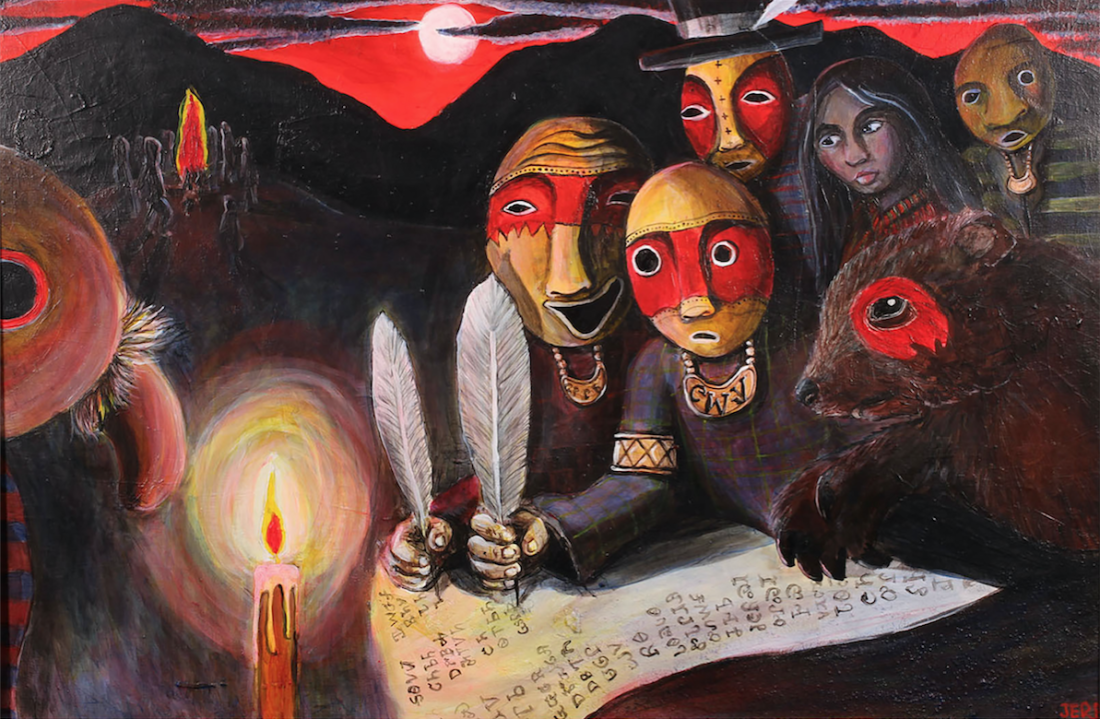Things began according to plan. In August 2015, the exhibit Return from Exile: Contemporary Southeastern Indian Art opened at the Lyndon House Arts Center in Athens, Ga. That fall, the show, which features the works of 32 contemporary Southeastern Native American artists, was supposed to travel west to its final destination in Tahlequah, Okla. The act was a symbolic gesture — the journey would retrace The Trail of Tears, the path the artists’ ancestors were forced to travel under the Indian Removal Act of 1830.
The collection, however, never did make it to Tahlequah. Two years later, the show is still on the road. Its co-curator and participating artist Bobby C. Martin says that, following its debut, Return from Exile “organically morphed into this … traveling exhibition.”
In August, the collection made its most recent stop at Western Carolina University’s Fine Art Museum at Bardo Arts Center, where it will remain on display through Friday, Dec. 8. In conjunction with the exhibit, the university will host a contemporary Native American art symposium on Friday, Nov. 10. The free, all-day event includes breakfast and lunch, along with panel discussions. Later that evening, there will be a reception saluting the works. The night will conclude with a ticketed performance from Canadian First Nations electronic music group, A Tribe Called Red.
Martin says the theme of the series is resilience. In part, he wants to honor and remember both the traditions and hardships imposed upon the five tribes of the Southeast Native Americans (Choctaw, Chickasaw, Cherokee, Muscogee and Seminole). He also hopes the show’s mediums, which include painting, drawing, printmaking, basketry, sculpture and pottery, will encourage greater community involvement within the arts. Last, Martin sees the exhibit as a way to highlight and celebrate the continued creative spirit that is present in current-day Southeastern tribe members. “We want to make sure people know we’re still around, we’re still creating, we’re still making viable art,” Martin says. “We didn’t just disappear when the removal happened.”
Faren Sanders Crews, a participating artist, echoes Martin’s final point. Crews, who now lives in Townsend, Ga., grew up on the Qualla Boundary in Cherokee. Along with her art, Crews often shares personal stories, as well as her tribe’s history and heritage, with classrooms and organizations. During one of these sessions, Crews notes, a little boy glared at her as she spoke. “He looked mad,” she recalls. Crews asked the boy if there was something wrong. The boy insisted Crews wasn’t a real Indian. She replied, “I’m not?” The boy answered, “No, all the Indians are dead.”
Miseducation and misperceptions like these are among the issues Return from Exile hopes to rectify, says Crews. History, she notes, “is a bitter, bitter page.” But, too often, Crews adds, the past is romanticized and misconstrued, if not completely whitewashed. She points to Christopher Columbus. “He was lost,” Crews says. “The man didn’t know where he was. And he was a fiend. He was a rapist and [imposed] slavery. But, in the history books, he’s a great explorer.”

Stereotypes are another of the ongoing battles the collection challenges through the works’ displays of courage, humanity and tradition. “We shouldn’t be mascots,” says Crews. “The headdress [and] the clothing we wear, these are not costumes.”
Both Crews and Martin are among the featured artists and experts who will speak at the panel discussions taking place during the all-day symposium. Topics will include a look at traditions; ways to collect, curate and conserve indigenous works; the business of Native art; and a conversation about the current, contemporary Southeastern Native art scene.
Local Cherokee artist Jeff Marley will also participate in the symposium. As a member of the Native American cooperative Qualla Arts and Crafts Mutual, Marley will take part in the panel addressing the business side of Native arts. “Each panel is a mix of folks who have artwork in the Return from Exile exhibition, as well as our local artists,” Marley explains. “Folks who come to the symposium will get a sense that, even though [some of the participants] are separated by thousands of miles, there is very much a consistency in the agenda we have as artists, the symbolism that we use as artists and, ultimately, our goal in conveying our culture and sense of place and sense of history.”
In Marley’s opinion, this is an exciting period for his tribe. He notes the inclusion of the Cherokee parlance in Apple products, as well as Microsoft programs. “Our language is now accessible,” he says, which is critical because, “we’re at the state with some of these things where, if we don’t do something now, then we will lose them.”
Marley views Native American art in a similar vein as the language. He hopes the symposium and exhibit will encourage new interest and participation in both the traditional and more modern mediums. Meanwhile, for Crews, the two events emphasize the resilience of the Southeastern tribes. Ideally, she says, the gathering will help to remind folks that “we are still here. We’re still alive and we still exist.”
And, she adds, “Amazingly, we still have our culture intact.”




Before you comment
The comments section is here to provide a platform for civil dialogue on the issues we face together as a local community. Xpress is committed to offering this platform for all voices, but when the tone of the discussion gets nasty or strays off topic, we believe many people choose not to participate. Xpress editors are determined to moderate comments to ensure a constructive interchange is maintained. All comments judged not to be in keeping with the spirit of civil discourse will be removed and repeat violators will be banned. See here for our terms of service. Thank you for being part of this effort to promote respectful discussion.